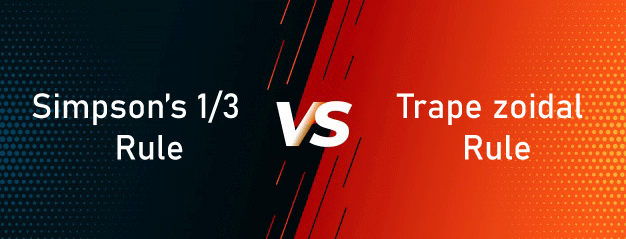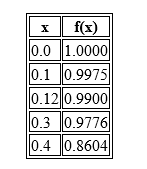Difference between Simpson's 1/3 rule and Trapezoidal RuleIn this article, we will understand the differences between the Simpson's 1/3 rule and Trapezoidal Rule. 
Simpson's 1/3 rule:This method is also called parabolic rules. In Simpson's 1/3 rule, we approximate the polynomial based on quadratic approximation. In this, each approximation actually covers two of the subintervals. This is why we require the number of subintervals to be even. Some of the approximations look more like a line than a quadric, but they really are quadratics Following is the Formula of Simpson's ¹/₃ rule ₐ∫ᵇ f (x) dx = h/₃ [(y₀ + yₙ) + 4 (y₁ + y₃ + ..) + 2(y₂ + y₄ + ..)] In this, a and b is the interval of integration h = (b - a) / n y₀ means the first terms and yₙ means the last terms. (y₁ + y₃ + ..) means the sum of odd terms. (y₂ + y₄ + …) means sum of even terms. Example: Find the Solution using Simpson's 1/3 rule.
Solution: By using Simpson's 1/3 rule ₐ∫ᵇ f (x) dx = h/₃ [(y₀ + yₙ) + 4 (y₁ + y₃ + …) + 2 (y₂ + y₄ + …)] h = 0.1 ₐ∫ᵇ f (x) dx = 0.1/3 [(1+0.8604)+4×(0.9975+0.9776)+2×(0.99)] ₐ∫ᵇ f (x) dx = 0.1/3 [(1+0.8604)+4×(1.9751)+2×(0.99)] ₐ∫ᵇ f (x) dx = 0.39136 Solution of Simpson's 1/3 rule = 0.39136 Trapezoidal MethodThis method is also known as the trapezium rule. In the trapezoidal rule, we approximate the curve with a straight line and hence can only be accurate for sufficiently small h. This rule gives the exact value of the integral of f(x) as a linear function. when several trapezoids are used, we call it the composite trapezoidal rule. Following is the Formula of Trapezoidal Method ₐ∫ᵇ f (x) dx = h/2 [(y₀ + yₙ) + 2(y1+ y2 + ..)] In this, a and b is the interval of integration h = (b - a)/ n y₀ means the first terms and yₙ means the last term. (y₁ + y2 + ..) means the sum of remaining terms. Example: Find the Solution using Trapezoidal MethodSolution: By using Trapezoidal Method ₐ∫ᵇ f (x) dx = h/2 [(y₀ + yₙ) + 2(y1+ y2 + ..)] h = (0.5 - 0) = (1 - 0.5) = (1.5 - 1) = 0.5 = (.5/2) [5 + 11 + 2 (6 + 9)] = 0.25 [16+30] = 0.25 [46] = 11.5 Solution of Trapezoidal Method = 11.5 Following are the differences between Simpson's 1/3 rule and Trapezoidal Rule
Next TopicDifference between
|
 For Videos Join Our Youtube Channel: Join Now
For Videos Join Our Youtube Channel: Join Now
Feedback
- Send your Feedback to [email protected]
Help Others, Please Share










